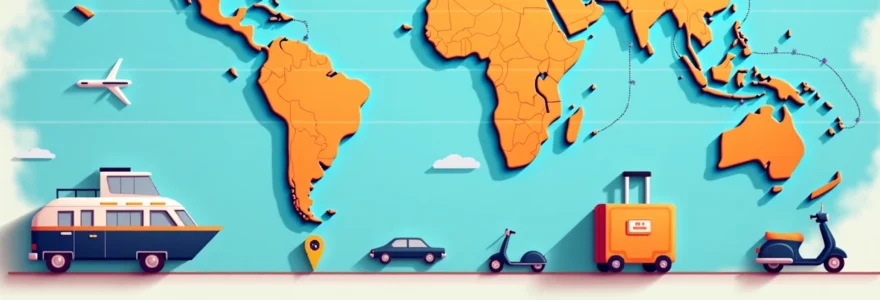Planning a multi-destination trip can be an exhilarating yet daunting task. The prospect of exploring multiple cities, countries, or even continents in a single journey offers unparalleled opportunities for adventure and cultural immersion. However, the complexity of coordinating various modes of transportation, accommodations, and activities across different locations can quickly become overwhelming. By employing strategic planning techniques and leveraging modern travel tools, you can transform what might seem like a logistical nightmare into a seamless and enriching experience.
Multi-destination itinerary optimization techniques
Crafting an efficient multi-destination itinerary requires a delicate balance between ambition and practicality. Start by mapping out your desired destinations and considering their geographical proximity. Group nearby locations together to minimize travel time and maximize exploration opportunities. Consider the optimal order of visits based on factors such as weather patterns, local events, and peak tourist seasons.
One effective technique is to use a hub-and-spoke model, where you establish a central base in each region and take day trips or short excursions to nearby attractions. This approach can reduce the number of times you need to change accommodations, allowing for a more relaxed pace and deeper engagement with each locale.
Another crucial aspect of itinerary optimization is allowing buffer time between major transitions. Building in flexible days or half-days can accommodate unexpected delays, spontaneous discoveries, or simply the need for rest. Remember, the goal is not to tick off as many destinations as possible, but to create a rich, fulfilling travel experience.
Transportation logistics for complex routes
Navigating the intricate web of transportation options is often the most challenging aspect of multi-destination travel planning. The key is to approach this task systematically, considering all available modes of transport and their relative efficiency for each leg of your journey.
Flight connection strategies: Hub-and-Spoke vs. Point-to-Point
When planning your air travel, you’ll encounter two primary flight network models: hub-and-spoke and point-to-point. The hub-and-spoke model centralizes traffic through major airports, often offering more frequent flights but potentially longer overall travel times due to layovers. Point-to-point routes, on the other hand, provide direct connections between smaller airports, which can be more efficient for certain itineraries.
To optimize your flight connections, consider using a combination of these models. For long-haul segments, hub-and-spoke routes might offer better prices and more reliable connections. For shorter distances within a region, point-to-point flights or alternative transportation modes could save time and reduce stress.
Intermodal travel: combining air, rail, and road transport
Embracing intermodal travel can significantly enhance the efficiency and enjoyment of your multi-destination trip. By combining different transportation modes, you can often create a more cost-effective and flexible itinerary. For instance, you might fly into a major city, use high-speed rail to explore nearby countries or regions, and then rent a car for more remote or rural areas.
When planning intermodal travel, pay close attention to connection times and the location of transportation hubs. Some cities have excellent integration between airports and train stations, while others might require significant travel time between different modes of transport.
Optimizing layovers: airport transit visas and city tours
Long layovers, often seen as a nuisance, can be transformed into mini-adventures with proper planning. Many airports offer free or low-cost city tours for passengers with extended layovers. Research whether your layover airports provide such services and consider adjusting your flight times to take advantage of these opportunities.
For layovers in countries that require transit visas, investigate whether you qualify for visa-free transit or if obtaining a transit visa is feasible. Some countries offer special provisions for transit passengers, allowing brief exits from the airport to explore nearby attractions.
Transport booking platforms: skyscanner, Rome2Rio, and omio
Leveraging specialized transport booking platforms can streamline your planning process and often uncover options you might not have considered. Skyscanner excels at finding flight combinations across multiple airlines, potentially saving you money and time. Rome2Rio offers a comprehensive overview of transportation options between any two points, including flights, trains, buses, and ferries. Omio specializes in European travel, providing seamless booking for trains and buses across multiple countries.
Using these tools in combination can help you construct a well-optimized transportation plan that balances cost, time, and convenience across your entire multi-destination journey.
Accommodation planning for multiple destinations
Securing suitable accommodations across multiple destinations requires a strategic approach that balances location, comfort, and budget considerations. The key is to remain flexible while ensuring that your lodging choices enhance rather than hinder your travel experience.
Strategic hotel booking: cancellation policies and flexibility
When booking accommodations for a multi-destination trip, prioritize flexibility. Look for hotels or rentals that offer free cancellation up to a reasonable date before your stay. This allows you to adjust your itinerary if necessary without incurring significant costs.
Consider booking accommodations with 24-hour reception services, especially for late arrivals or early departures. This can alleviate stress when dealing with varying transportation schedules across different time zones.
Alternative lodging: airbnb, couchsurfing, and hostels
Incorporating a mix of accommodation types can enhance your travel experience and potentially reduce costs. Airbnb and similar vacation rental platforms often provide more space and local flavor than traditional hotels, particularly for longer stays. Couchsurfing offers a unique opportunity to connect with locals and gain insider knowledge of your destination, though it requires more flexibility and openness.
Hostels, no longer just for backpackers, can be an excellent option for solo travelers or those looking to meet fellow globetrotters. Many modern hostels offer private rooms alongside dormitory-style accommodations, providing a social atmosphere without sacrificing privacy.
Loyalty programs: maximizing points across hotel chains
For frequent travelers, strategically using hotel loyalty programs can yield significant benefits on multi-destination trips. Focus on accumulating points within one or two major hotel groups that have broad geographical coverage. This approach can lead to free nights, room upgrades, and other perks that enhance your travel experience.
Consider credit cards that offer transferable points to multiple hotel programs, providing greater flexibility in your accommodation choices while still earning and redeeming valuable rewards.
Efficient packing strategies for Multi-Stop journeys
Packing for a multi-destination trip presents unique challenges, as you need to prepare for various climates, activities, and cultural contexts while keeping your luggage manageable. Adopting efficient packing strategies is crucial for maintaining mobility and reducing stress throughout your journey.
Capsule wardrobe techniques for versatile travel attire
Embrace the concept of a travel capsule wardrobe to maximize outfit combinations while minimizing the number of items you pack. Focus on versatile pieces that can be dressed up or down and are suitable for various activities. Choose a cohesive color palette to ensure that all items can be mixed and matched easily.
Invest in high-quality, wrinkle-resistant fabrics that can withstand frequent wear and quick washing in hotel sinks. Pack clothing that serves multiple purposes, such as a sarong that can function as a beach cover-up, scarf, or makeshift towel.
Tech essentials: universal adapters and portable chargers
When traveling across multiple countries, a universal adapter becomes an indispensable item. Look for a compact adapter that covers all the regions you’ll be visiting and includes USB ports for charging multiple devices simultaneously.
A high-capacity portable charger can be a lifesaver, especially when navigating unfamiliar cities or during long transit days. Opt for a model that can fully charge your smartphone multiple times and is compatible with airline carry-on regulations.
Luggage selection: Carry-On optimization vs. checked baggage
For multi-destination trips, the debate between carry-on only and checked baggage becomes particularly relevant. Traveling with only a carry-on offers greater flexibility and reduces the risk of lost luggage during multiple transfers. However, it requires more disciplined packing and may limit your ability to bring back souvenirs.
If you opt for checked baggage, consider using packing cubes or compression bags to organize your belongings and maximize space. Always pack a change of clothes and essential items in your carry-on in case your checked bag is delayed.
Digital tools for Multi-Destination trip management
Leveraging digital tools can significantly streamline the planning and execution of a multi-destination trip. From itinerary management to budgeting and navigation, a well-chosen suite of apps can help you stay organized and adaptable throughout your journey.
Travel planning apps: TripIt, google trips, and roadtrippers
TripIt stands out as a comprehensive travel organizer, automatically compiling your reservations into a master itinerary. It syncs across devices and can be shared with travel companions or family members back home. Google Trips, while no longer available as a standalone app, offers similar functionality integrated into Google Maps and Gmail, providing personalized trip information based on your reservations and searches.
For road trip segments of your multi-destination journey, Roadtrippers excels at suggesting interesting stops and attractions along your route, helping you discover hidden gems and make the most of your travel between major destinations.
Budgeting software: trail wallet and mint for travel expenses
Keeping track of expenses across multiple currencies and destinations can be challenging. Trail Wallet is designed specifically for travelers, allowing you to set daily budgets, categorize expenses, and easily switch between currencies. For those who prefer a more comprehensive financial overview, Mint can be adapted for travel use, offering insights into your spending patterns and helping you stay within your overall trip budget.
Navigation tools: maps.me and CityMapper for offline use
Reliable navigation is crucial when exploring multiple unfamiliar destinations. Maps.me offers detailed offline maps and navigation capabilities, which can be invaluable in areas with limited internet access or when trying to avoid data roaming charges. For urban exploration, CityMapper provides comprehensive public transit information and routing for major cities worldwide, often surpassing native mapping apps in accuracy and ease of use.
Cultural preparation and language considerations
Preparing for the cultural and linguistic diversity you’ll encounter on a multi-destination trip is essential for a rich and respectful travel experience. Taking time to understand local customs and learn basic phrases in multiple languages can greatly enhance your interactions and overall enjoyment of each destination.
Language learning apps: duolingo and babbel for quick phrases
While achieving fluency in multiple languages for a single trip is unrealistic, learning key phrases can go a long way in showing respect and facilitating basic interactions. Duolingo offers a gamified approach to language learning that can make picking up essential vocabulary fun and engaging. Babbel focuses more on conversational language and real-life scenarios, which can be particularly useful for travel-specific phrases.
Aim to learn at least basic greetings, numbers, and polite expressions in the languages of your destinations. Even if you quickly revert to English or gestures, the effort to speak the local language is often appreciated.
Cultural etiquette research: geert hofstede’s cultural dimensions
Understanding the cultural norms of your destinations can help you navigate social interactions more smoothly and avoid unintentional faux pas. Geert Hofstede’s Cultural Dimensions theory provides a framework for comparing cultural values across countries, offering insights into aspects such as power distance, individualism versus collectivism, and long-term orientation.
Research specific etiquette guidelines for each destination, paying attention to customs around greetings, dining, tipping, and dress codes. This knowledge will help you show respect for local traditions and potentially open doors to more meaningful cultural exchanges.
Local SIM cards vs. international data plans
Staying connected across multiple destinations requires careful consideration of your mobile data options. Local SIM cards often offer the most cost-effective data rates but require an unlocked phone and can be time-consuming to acquire in each new country. International data plans from your home carrier provide convenience but may be more expensive.
For extended multi-destination trips, consider a global SIM card that offers competitive rates across multiple countries. Alternatively, rely on Wi-Fi where possible and use offline maps and translation apps to reduce your data dependency.
By thoroughly addressing these aspects of cultural and linguistic preparation, you’ll be well-equipped to engage meaningfully with the diverse environments you’ll encounter on your multi-destination journey. Remember, the goal is not just to visit multiple places, but to truly experience and appreciate the unique characteristics of each destination.


